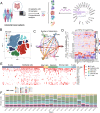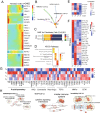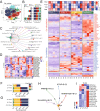Single-cell N6-methyladenosine regulator patterns guide intercellular communication of tumor microenvironment that contribute to colorectal cancer progression and immunotherapy
- PMID: 35509079
- PMCID: PMC9066909
- DOI: 10.1186/s12967-022-03395-7
Single-cell N6-methyladenosine regulator patterns guide intercellular communication of tumor microenvironment that contribute to colorectal cancer progression and immunotherapy
Abstract
Background: N6-methyladenosine (m6A) RNA methylation plays a critical role in key genetic events for various cancers; yet, how m6A functions within the tumor microenvironment (TME) remains to be elucidated.
Methods: A total of 65,362 single cells from single-cell RNA-seq data derived from 33 CRC tumor samples were analyzed by nonnegative matrix factorization (NMF) for 23 m6A RNA methylation regulators. CRC and Immunotherapy cohorts from public repository were used to determine the prognosis and immune response of TME clusters.
Results: The fibroblasts, macrophages, T and B cells were respectively grouped into 4 to 5 subclusters and then classified according to various biological processes and different marker genes. Furthermore, it revealed that the m6A RNA methylation regulators might be significantly related to the clinical and biological features of CRC, as well as the pseudotime trajectories of main TME cell types. Bulk-seq analysis suggested that these m6A-mediated TME cell subclusters had significant prognostic value for CRC patients and distinguished immune response for patients who underwent ICB therapy, especially for the CAFs and macrophages. Notably, CellChat analysis revealed that RNA m6A methylation-associated cell subtypes of TME cells manifested diverse and extensive interaction with tumor epithelial cells. Further analysis showed that ligand-receptor pairs, including MIF - (CD74 + CXCR4), MIF - (CD74 + CD44), MDK-NCL and LGALS9 - CD45, etc. mediated the communication between m6A associated subtypes of TME cells and tumor epithelial cells.
Conclusions: Taken together, our study firstly revealed the m6A methylation mediated intercellular communication of the tumor microenvironment in the regulation of tumor growth and antitumor immunomodulatory processes.
Keywords: Colorectal cancer; Immunotherapy; Prognosis; Single-cell; Tumor microenvironment; m6A.
© 2022. The Author(s).
Conflict of interest statement
The authors declare that they have no conflicts of interest for this work.
Figures






Similar articles
-
Single-cell disulfidptosis regulator patterns guide intercellular communication of tumor microenvironment that contribute to kidney renal clear cell carcinoma progression and immunotherapy.Front Immunol. 2024 Jan 16;15:1288240. doi: 10.3389/fimmu.2024.1288240. eCollection 2024. Front Immunol. 2024. PMID: 38292868 Free PMC article.
-
Single-Cell Analysis Reveals Histone Deacetylation Factor Guide Intercellular Communication of Tumor Microenvironment that Contribute to Colorectal Cancer Progression and Immunotherapy.Biochem Genet. 2025 Apr;63(2):1862-1879. doi: 10.1007/s10528-024-10730-8. Epub 2024 Apr 18. Biochem Genet. 2025. PMID: 38637426
-
Single-cell dissection reveals the role of DNA damage response patterns in tumor microenvironment components contributing to colorectal cancer progression and immunotherapy.Genes Cells. 2023 May;28(5):348-363. doi: 10.1111/gtc.13017. Epub 2023 Mar 3. Genes Cells. 2023. PMID: 36811212
-
N6-Methyladenosine RNA Modification in the Tumor Immune Microenvironment: Novel Implications for Immunotherapy.Front Immunol. 2021 Dec 9;12:773570. doi: 10.3389/fimmu.2021.773570. eCollection 2021. Front Immunol. 2021. PMID: 34956201 Free PMC article. Review.
-
N6-Methyladenosine in Cancer Immunotherapy: An Undervalued Therapeutic Target.Front Immunol. 2021 Aug 30;12:697026. doi: 10.3389/fimmu.2021.697026. eCollection 2021. Front Immunol. 2021. PMID: 34526985 Free PMC article. Review.
Cited by
-
FABP6 serves as a new therapeutic target in esophageal tumor.Aging (Albany NY). 2024 Jan 25;16(2):1640-1662. doi: 10.18632/aging.205448. Epub 2024 Jan 25. Aging (Albany NY). 2024. PMID: 38277205 Free PMC article.
-
Identification of dynamic network biomarker ITGB1 for erlotinib pre-resistance using single-cell differential covariance entropy.Mol Ther Oncol. 2025 May 15;33(2):200993. doi: 10.1016/j.omton.2025.200993. eCollection 2025 Jun 18. Mol Ther Oncol. 2025. PMID: 40546313 Free PMC article.
-
Tumor-associated characteristics and immune dysregulation in nasopharyngeal carcinoma under the regulation of m7G-related tumor microenvironment cells.World J Surg Oncol. 2024 Jun 25;22(1):166. doi: 10.1186/s12957-024-03441-2. World J Surg Oncol. 2024. PMID: 38918785 Free PMC article.
-
Defining gastric cancer ecology: the crucial roles of TREM2+ macrophages and fibroblasts in tumor microenvironments.Commun Biol. 2025 Mar 28;8(1):514. doi: 10.1038/s42003-025-07512-2. Commun Biol. 2025. PMID: 40155473 Free PMC article.
-
RNA methylation patterns of tumor microenvironment cells regulate prognosis and immunotherapeutic responsiveness in patients with triple-negative breast cancer.Sci Rep. 2024 Oct 30;14(1):26075. doi: 10.1038/s41598-024-77941-2. Sci Rep. 2024. PMID: 39478153 Free PMC article.
References
-
- Sung H, Ferlay J, Siegel RL, Laversanne M, Soerjomataram I, Jemal A, Bray F. Global Cancer Statistics 2020: GLOBOCAN Estimates of Incidence and Mortality Worldwide for 36 Cancers in 185 Countries. CA Cancer J Clin. 2021;71:209–249. - PubMed
-
- Li M, Zha X, Wang S. The role of N6-methyladenosine mRNA in the tumor microenvironment. Biochim Biophys Acta Rev Cancer. 2021;1875:188522. - PubMed
-
- Roignant JY, Soller M. m (6)A in mRNA: An Ancient Mechanism for Fine-Tuning Gene Expression. Trends Genet. 2017;33:380–390. - PubMed
Publication types
MeSH terms
Substances
LinkOut - more resources
Full Text Sources
Medical
Research Materials
Miscellaneous

